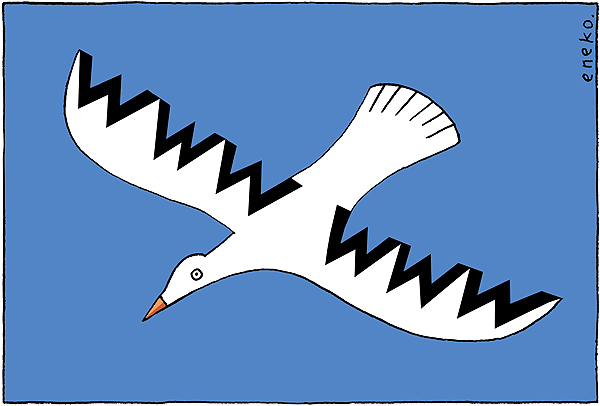 (Drawing by Eneko/20minutos.es
(Drawing by Eneko/20minutos.es)
[from
Spanish activists issue manifesto on the rights of Internet users and
Manifiesto “En defensa de los derechos fundamentales en internet”].A group of journalists, bloggers, professionals and creators want to express their firm opposition to the inclusion in a Draft Law of some changes to Spanish laws restricting the freedoms of expression, information and access to culture on the Internet. We also declare that:
1 .- Copyright should not be placed above citizens' fundamental rights to privacy, security, presumption of innocence, effective judicial protection and freedom of expression.
2 .- Suspension of fundamental rights is and must remain an exclusive competence of judges. This blueprint, contrary to the provisions of Article 20.5 of the Spanish Constitution, places in the hands of the executive the power to keep Spanish citizens from accessing certain websites.
3 .- The proposed laws would create legal uncertainty across Spanish IT companies, damaging one of the few areas of development and future of our economy, hindering the creation of startups, introducing barriers to competition and slowing down its international projection.
4 .- The proposed laws threaten creativity and hinder cultural development. The Internet and new technologies have democratized the creation and publication of all types of content, which no longer depends on an old small industry but on multiple and different sources.
5 .- Authors, like all workers, are entitled to live out of their creative ideas, business models and activities linked to their creations. Trying to hold an obsolete industry with legislative changes is neither fair nor realistic. If their business model was based on controlling copies of any creation and this is not possible any more on the Internet, they should look for a new business model.
6 .- We believe that cultural industries need modern, effective, credible and affordable alternatives to survive. They also need to adapt to new social practices.
7 .- The Internet should be free and not have any interference from groups that seek to perpetuate obsolete business models and stop the free flow of human knowledge.
8 .- We ask the Government to guarantee net neutrality in Spain, as it will act as a framework in which a sustainable economy may develop.
9 .- We propose a real reform of intellectual property rights in order to ensure a society of knowledge, promote the public domain and limit abuses from copyright organizations.
10 .- In a democracy, laws and their amendments should only be adopted after a timely public debate and consultation with all involved parties. Legislative changes affecting fundamental rights can only be made in a Constitutional law.
 In order to avoid the later release of this carbon when the plant dies or is destroyed, biochar technology could be used. Biochar (stable, solid and rich-in-carbon-content char created by pyrolysis of biomass) helps to lock carbon in the solid state for long periods of time. Done right, experts say, biochar produced and used appropriately, could contribute to the removal of carbon in combination with the millennia old technology of plant photosynthesis.
In order to avoid the later release of this carbon when the plant dies or is destroyed, biochar technology could be used. Biochar (stable, solid and rich-in-carbon-content char created by pyrolysis of biomass) helps to lock carbon in the solid state for long periods of time. Done right, experts say, biochar produced and used appropriately, could contribute to the removal of carbon in combination with the millennia old technology of plant photosynthesis.




